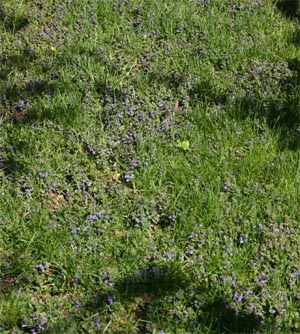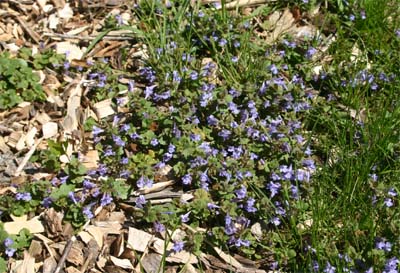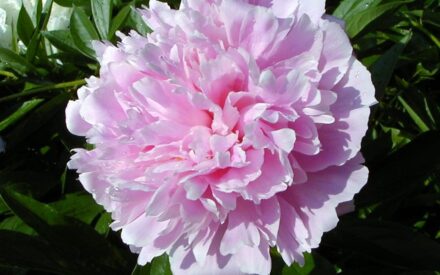
Creeping Charlie, ground ivy, gill-on-the-ground, creeping Jenny – it doesn’t matter what name you call it, this is a weed that’s difficult to control. Glechoma hederacea is a perennial weed in the mint family that spreads by seeds, rhizomes and creeping stems that root at the nodes. This European native was introduced to North America by early settlers who thought it was a good groundcover for shade. The bright green, round or kidney-shaped leaves have scalloped edges and are produced opposite each other on the square (four-sided) stem. In spring small, bluish-purple, funnel-shaped flowers bloom on short stems. When the plant is crushed, it produces a strong mint-like odor.
Creeping Charlie thrives in moist, shady spots such as under trees and shrubs. If you can alter these conditions, it will be easier to discourage this weed. If possible, improve soil drainage or water less frequently, or prune trees up so the area receives more light. If the area is weak or the lawn thin, try to improve turf health and density by mowing regularly at a height of 2 – 3½ inches, fertilizing as appropriate for the grass type, overseeding in the fall, and watering properly. Also, make sure you’re growing the most suitable type of turfgrass for the area (shade tolerant varieties under trees). Or consider removing the grass and growing shade-loving plants that compete well with weeds, such as vinca, English ivy, pachysandra or hosta.

You can hand-pull creeping Charlie, but it’s difficult to completely remove the extensive creeping stem system so this may not be a viable solution if the area is heavily infested. Make sure to remove the plants you’ve pulled so they can’t re-root. A dethatching tool, also called a power rake or vertical mower, can be used to clean up larger areas of creeping Charlie-infested lawn. This tool makes small cuts in the soil and the roots so you can “comb out” the creeping Charlie with a rake. But beware that this can make the problem worse by spreading nodes and inducing their development into new plants. This also cuts out some of the grass as well, so you may need to reseed after dethatching. The best time to do this is mid-August to mid-September, which is also the best time to reseed your lawn.
Borax has been touted as an organic control for creeping Charlie, but research at both the University of Wisconsin and Iowa State University has shown that borax is typically not very effective and can injure turf and other plants as well, causing stunting and yellowing. Borax contains boron, which is necessary in very small amounts for plant growth but is toxic in larger doses. Creeping Charlie happens to be extremely sensitive to boron, so supplying more boron should be detrimental to it more than other plants, such as grass, that aren’t as sensitive. However, since boron availability in the soil depends on soil type and pH, it’s difficult to determine just how much boron should be applied in any one place. And there’s little room for error: too little results in poor control and too much injures surrounding plants. Also, boron doesn’t break down or dissipate in the soil, so repeated or excessive applications can result in bare areas where no vegetation can grow.

The best means of controlling creeping Charlie is with a postemergence broadleaf herbicide. As with any pesticide, always read and follow label directions. The best choice for homeowners is a weed killer containing salt of dicamba (3, 6-dichloro-o-anisic acid) or triclopyr. These active ingredients are often found in combination products, such as Trimec or Three Way Lawn Weed Killer, so check the ingredient list on the label to see if it contains dicamba or triclopyr. The other chemicals in these combinations are generally 2,4-D (2, 4 dichlorophenoxyacetic acid) and mecoprop or MCPP (2-(2-methly-4-chlorophenoxy) propionic acid). These products are good for applications on lawns, but can’t be used in vegetable or flower gardens as many broadleaf plants are very susceptible to these herbicides and even minimal amounts of the herbicide will cause severe injury. In those areas it’s best to hand pull or hoe the invaders. If there’s more creeping Charlie than grass in your lawn, it may be easier to start over by killing all the vegetation and reseeding the lawn.

Herbicide applications should be made when the weeds are actively growing. Mid to late autumn, after the first frost, is an excellent time to apply herbicides to creeping Charlie and other perennial broadleaf weeds. At this time the plants are busily sending food reserves to the roots, so the herbicide is moved down to the roots as well, resulting in better control. A second application can be made again the following spring, but wait until the plants are in bloom (April to June) as the plants are most susceptible to herbicides then. Again, a second application may be necessary.
For best results make applications when temperatures are in the mid 60s to low 80s, there is no rain expected for 24 hours following application, and there is little or no wind. When applying herbicides to lawns, don’t mow the area for a few days before and after application.
Controlling creeping Charlie takes some work and is frequently not totally successful. Herbicide applications may be needed on a regular basis for many years to completely eliminate the weed. It may be easier to just learn to live with it, and periodically knock back the weed when it becomes too dense.
– Susan Mahr, University of Wisconsin – Madison
Additional Information
- Borax on Ground Ivy: Boon or Bane? – Iowa State University’s Horticulture & Home Pest News
- Controlling Creeping Charlie – information on the UW Hort website
- Weed Control in Lawns and Other Turf – University of Minnesota Extension Bulletin FS-01137





 Alternatives to Lawn: Groundcovers
Alternatives to Lawn: Groundcovers Marigolds
Marigolds Peony
Peony Iris Severe Mosaic
Iris Severe Mosaic


